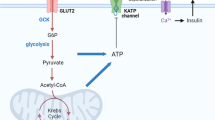Abstract
The hyperinsulinism/hyperammonemia (HI/HA) syndrome is the second most common form of congenital hyperinsulinism (HI). Children affected by this syndrome have both fasting and protein sensitive hypoglycemia combined with persistently elevated ammonia levels. Gain of function mutations in the mitochondrial enzyme glutamate dehydrogenase (GDH) are responsible for the HI/HA syndrome. GDH is expressed in liver, kidney, brain, and pancreatic beta-cells. Patients with the HI/HA syndrome have an increased frequency of generalized seizures, especially absence-type seizures, in the absence of hypoglycemia. The hypoglycemia of the HI/HA syndrome is well controlled with diazoxide, a KATP channel agonist. GDH has also been implicated in another form of HI, short-chain 3-hydroxyacyl-CoA dehydrogenase (SCHAD) deficiency associated HI. The HI/HA syndrome provides a rare example of an inborn error of intermediary metabolism in which the effect of the mutation on enzyme activity is a gain of function.








Similar content being viewed by others
References
Cochrane WA, Payne WW, Simpkiss MJ, Woolf LI. Familial hypoglycemia precipitated by amino acids. J Clin Invest. 1956;35:411–22.
Zammarchi E, Filippi L, Novembre E, Donati MA. Biochemical evaluation of a patient with a familial form of leucine-sensitive hypoglycemia and concomitant hyperammonemia. Metabolism. 1996;45:957–60.
Stanley CA, Lieu YK, Hsu BYL, Burlina AB, Greenberg CR, Hopwood NJ, et al. Hyperinsulinism and hyperammonemia in infants with regulatory mutations of the glutamate dehydrogenase gene. N Engl J Med. 1998;338:1352–7.
Stanley CA. The hyperinsulinism-hyperammonemia syndrome: gain of function mutations of glutamate dehydrogenase. In: Dunger DB, editor. Genetic insights in paediatric endocrinology and metabolism. Bristol: BioScientifica; 2000. p. 23–30.
MacMullen C, Fang J, Hsu BYL, Kelly A, deLonlay-Debeney P, Saudubray JM, et al. Hyperinsulinism/Hyperammonemia syndrome in children with regulatory mutations in the inhibitory GTP binding domain of glutamate dehydrogenase. J Clin Endocrinol Metab. 2001;86:1782–7
Hsu BY, Kelly A, Thornton PS, Greenberg CR, Dilling LA, Stanley CA. Protein-sensitive and fasting hypoglycemia in children with the hyperinsulinism/hyperammonemia syndrome. J Pediatr. 2001;138:383–9.
Stanley CA, Fang J, Kutyna K, Hsu BY, Ming JE, Glaser B, et al. Molecular basis and characterization of the hyperinsulinism/hyperammonemia syndrome: predominance of mutations in exons 11 and 12 of the glutamate dehydrogenase gene. Diabetes. 2000;49:667–73.
Huijmans JGM, Duran M, DeKlerk JBC, Rovers MJ, Scholte HR. Functional hyperactivity of hepatic glutamate dehydrogenase as a cause of the hyperinsulinism/hyperammonemia syndrome: effect of treatment. Pediatrics. 2000;106:596–600.
Weinzimer SA, Stanley CA, Berry GT, Yudkoff M, Tuchman M, Thornton PS. A syndrome of congenital hyperinsulinism and hyperammonemia. J Pediatr. 1997;130:661–4.
de Lonlay P, Benelli C, Fouque F, Ganguly A, Aral B, Dionisi Vicci C, et al. Hyperinsulinism and hyperammonemia syndrome: report of twelve unrelated patients. Pediatr Res. 2001;50:353–7.
Kelly A, Ng D, Ferry Jr RJ, Grimberg A, Koo-McCoy S, Thornton PS, et al. Acute insulin responses to leucine in children with the hyperinsulinism/hyperammonemia syndrome. J Clin Endocrinol Metab. 2001;86:3724–8.
Stewart PM, Walser M. Short term regulation of ureagenesis. J Biol Chem. 1980;255:5270–80.
Treberg JR, Clow KA, Greene KA, Brosnan ME, Brosnan JT. Systemic activation of glutamate dehydrogenase increases renal ammoniagenesis: implications for the hyperinsulinism/hyperammonemia syndrome. Am J Physiol Endocrinol Metab. 2010;298:E1219–25.
Raizen DM, Brooks-Kayal A, Steinkrauss L, Tennekoon GI, Stanley CA, Kelly A. Central Nervous System hyperexcitability associated with glutamate dehydrogenase gain of function mutations. J Pediatr. 2005;146:388–94.
Li C, Najafi H, Daikhin Y, Nissim IB, Collins HW, Yudkoff M, et al. Regulation of leucine-stimulated insulin secretion and glutamine metabolism in isolated rat islets. J Biol Chem. 2003;278:2853–8.
Hudson RC, Daniel RM. L-glutamate dehydrogenases: distribution, properties and mechanism. Comp Biochem Physiol B. 1993;106:767–92.
Smith TJ, Peterson PE, Schmidt T, Fang J, Stanley CA. Structures of bovine glutamate dehydrogenase complexes elucidate the mechanism of purine regulation. J Mol Biol. 2001;23:707–20.
Smith TJ, Stanley CA. Untangling the glutamate dehydrogenase allosteric nightmare. Trends Biochem Sci. 2008;33:557–64.
Fang J, Hsu BY, MacMullen CM, Poncz M, Smith TJ, Stanley CA. Expression, purification and characterization of human glutamate dehydrogenase (GDH) allosteric regulatory mutations. Biochem J. 2002;363:81–7.
Bahi-Buisson N, Roze E, Dionisi C, Escande F, Boddaert N, Valayannopoulos V, et al. Myoclonic absence epilepsy with photosensitivity and a gain of function mutation in glutamate dehydrogenase. Seizure. 2008;17:658–64.
Kapoor RR, Flanagan SE, Fulton P, Chakrapani A, Chadefaux B, Ben-Omran T, et al. Hyperinsulinism-hyperammonemia syndrome: novel mutations in the GLUD1 gene and genotype-phenotype correlations. Eur J Endocrinol. 2009;161:731–5.
Bahi-Buisson N, Roze E, Dionisi C, Escande F, Valayannopoulos V, Feillet F, et al. Neurological aspects of hyperinsulinism-hyperammonaemia syndrome. Dev Med Child Neurol. 2008;50:945–9.
Li C, Chen P, Palladino A, Narayan S, Russell LK, Sayed S, et al. Mechanism of hyperinsulinism in short-chain 3-hydroxyacyl-CoA dehydrogenase deficiency involves activation of glutamate dehydrogenase. J Biol Chem. 2010;285:31806–18.
Kapoor RR, James C, Flanagan SE, Ellard S, Eaton S, Hussain K. 3-hydroxyacyl-coenzyme A dehydrogenase deficiency and hyperinsulinemic hypoglycemia: characterization of a novel mutation and severe dietary protein sensitivity. J Clin Endocrinol Metab. 2009;94:2221–5.
Acknowledgements
This work was supported in part by grants from the NIH (UL1 RR024134, RO1 DK 56268, RO1 DK 53012 to CAS) and from the Society for Inherited Metabolic Disorders.
Author information
Authors and Affiliations
Corresponding author
Rights and permissions
About this article
Cite this article
Palladino, A.A., Stanley, C.A. The hyperinsulinism/hyperammonemia syndrome. Rev Endocr Metab Disord 11, 171–178 (2010). https://doi.org/10.1007/s11154-010-9146-0
Published:
Issue Date:
DOI: https://doi.org/10.1007/s11154-010-9146-0




